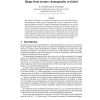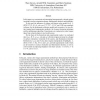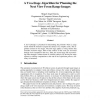BMVC
1998
14 years 1 months ago
1998
We present a method for learning appearance models that can be used to recognise and track both 3D head pose and identities of novel subjects with continuous head movement across ...
BMVC
2000
14 years 1 months ago
2000
The objective of this paper is to estimate the orientation of a scene plane from an uncalibrated perspective image under the assumption that the scene is coated with a homogeneous...
BMVC
1998
14 years 1 months ago
1998
The segmentation of pixels belonging to different moving elements within a cinematographic image sequence underpins a range of post-production special effects. In this work, the s...
BMVC
1998
14 years 1 months ago
1998
BMVC
1998
14 years 1 months ago
1998
Snakes provide high-level information in the form of continuity constraints and minimum energy constraints related to the contour shape and image features. These image features ar...
BMVC
1998
14 years 1 months ago
1998
A new technique is presented for determining the positions where a range sensor should be located to acquire the surfaces of a complex scene. The algorithm consists of two stages....
BMVC
1998
14 years 1 months ago
1998
Evaluating the performance of optical flow algorithms has been difficult because of the lack of ground-truth data sets for complex scenes. We describe a simple modification to a r...
BMVC
1998
14 years 1 months ago
1998
This paper presents an enhanced hypothesis verification strategy for 3D object recognition. A new learning methodology is presented which integrates the traditional dichotomic obj...
BMVC
1998
14 years 1 months ago
1998
The classification of sets of mixed pixels can be accomplished by making use of the relationship of higher order moments of the distributions of the pure and mixed classes. As a c...
BMVC
1998
14 years 1 months ago
1998
In this paper we present an algorithm to compute set-point (i.e. a position to be reached by the robot) automatically from conic features virtually placed by an operator onto the ...



